CX660018: Organisational Performance Improvement Project Proposal
VerifiedAdded on 2022/11/23
|14
|4234
|198
Report
AI Summary
This project proposal examines the challenges faced by Hollywood Bakery Company, specifically staff shortages and high staff turnover. The report, written as part of the Auckland International Campus CX660018 course, aims to determine the causes of these issues, explore employee retention strategies, and propose solutions to improve organisational performance. It reviews relevant literature on the hospitality industry, employee retention factors, and superior-subordinate relationships, as well as the importance of training and development and the work environment. The project's objectives include determining the basis of staff shortage, examining the root causes of high staff turnover, and identifying effective employee retention approaches. The report will also cover project goals, objectives, resource requirements, and timelines for the project.
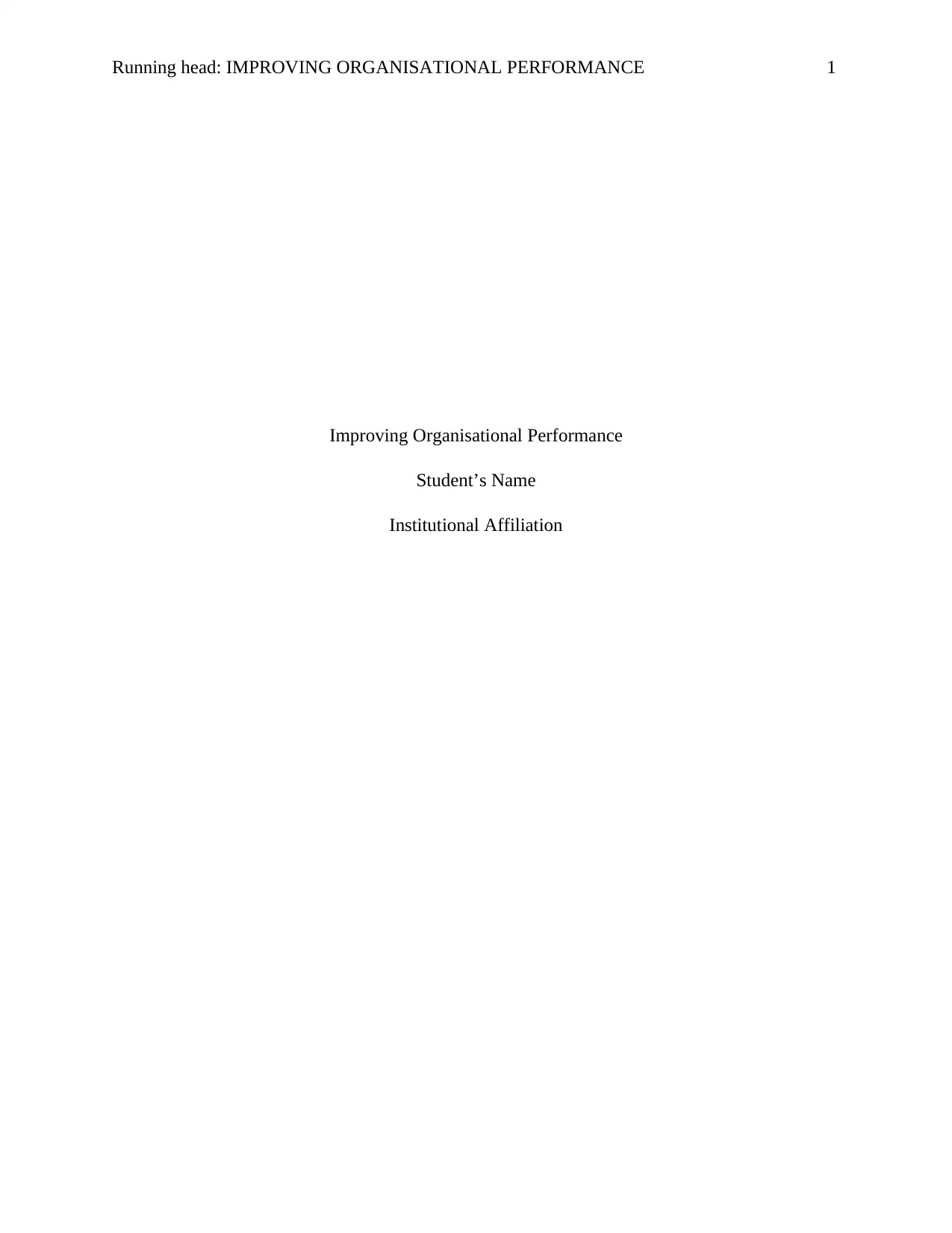
Running head: IMPROVING ORGANISATIONAL PERFORMANCE 1
Improving Organisational Performance
Student’s Name
Institutional Affiliation
Improving Organisational Performance
Student’s Name
Institutional Affiliation
Paraphrase This Document
Need a fresh take? Get an instant paraphrase of this document with our AI Paraphraser
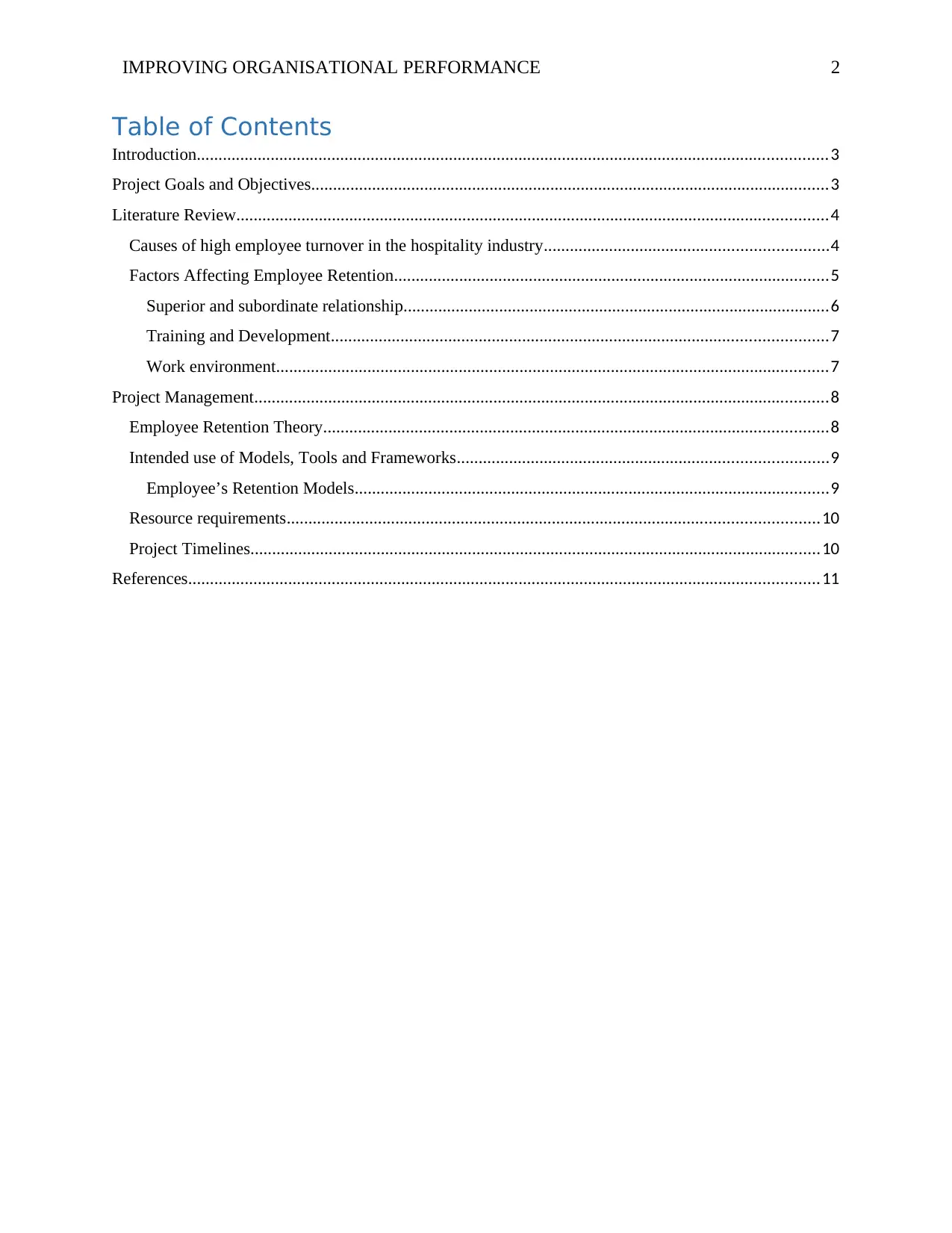
IMPROVING ORGANISATIONAL PERFORMANCE 2
Table of Contents
Introduction.................................................................................................................................................3
Project Goals and Objectives.......................................................................................................................3
Literature Review........................................................................................................................................4
Causes of high employee turnover in the hospitality industry.................................................................4
Factors Affecting Employee Retention....................................................................................................5
Superior and subordinate relationship..................................................................................................6
Training and Development..................................................................................................................7
Work environment...............................................................................................................................7
Project Management....................................................................................................................................8
Employee Retention Theory....................................................................................................................8
Intended use of Models, Tools and Frameworks.....................................................................................9
Employee’s Retention Models.............................................................................................................9
Resource requirements..........................................................................................................................10
Project Timelines...................................................................................................................................10
References.................................................................................................................................................11
Table of Contents
Introduction.................................................................................................................................................3
Project Goals and Objectives.......................................................................................................................3
Literature Review........................................................................................................................................4
Causes of high employee turnover in the hospitality industry.................................................................4
Factors Affecting Employee Retention....................................................................................................5
Superior and subordinate relationship..................................................................................................6
Training and Development..................................................................................................................7
Work environment...............................................................................................................................7
Project Management....................................................................................................................................8
Employee Retention Theory....................................................................................................................8
Intended use of Models, Tools and Frameworks.....................................................................................9
Employee’s Retention Models.............................................................................................................9
Resource requirements..........................................................................................................................10
Project Timelines...................................................................................................................................10
References.................................................................................................................................................11
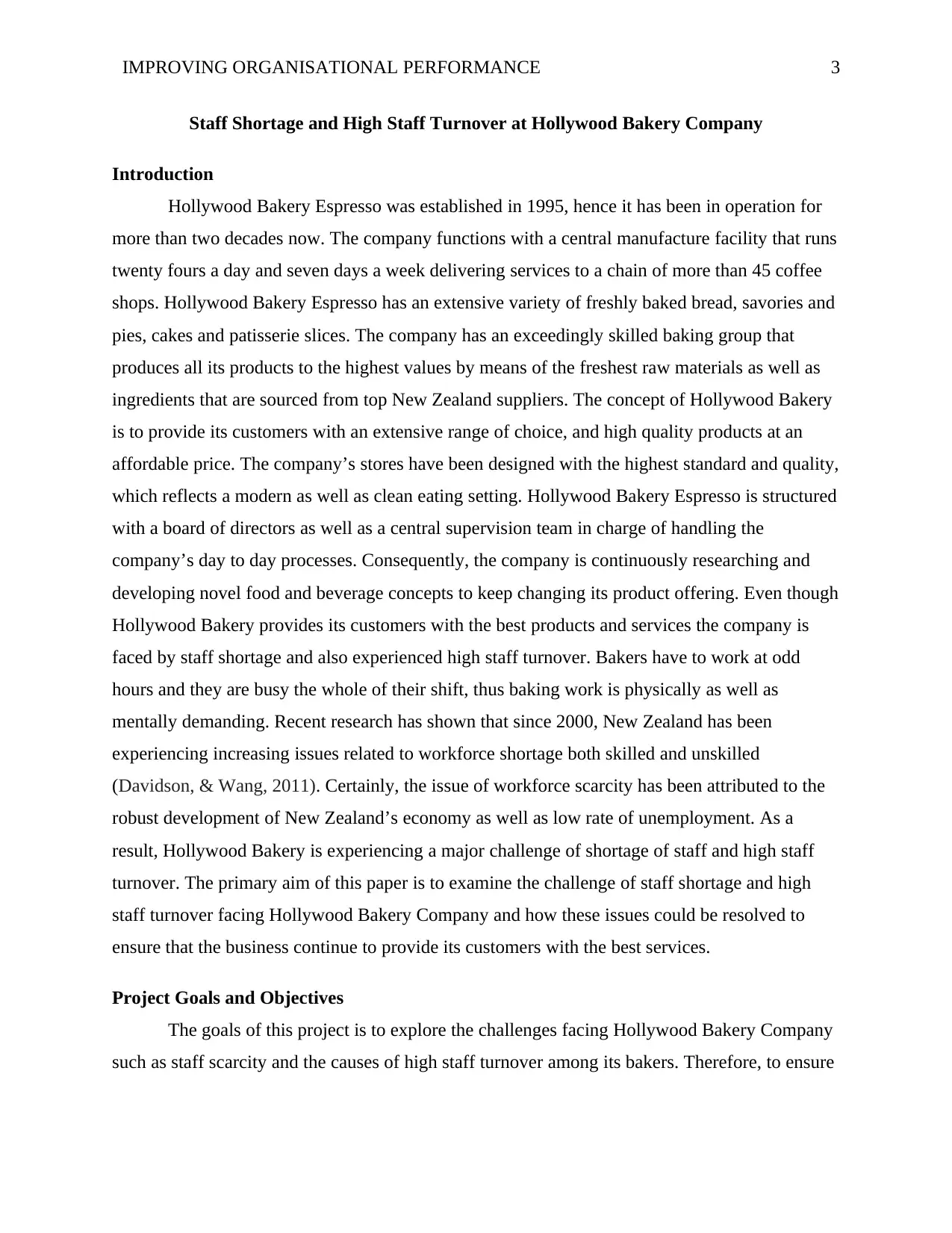
IMPROVING ORGANISATIONAL PERFORMANCE 3
Staff Shortage and High Staff Turnover at Hollywood Bakery Company
Introduction
Hollywood Bakery Espresso was established in 1995, hence it has been in operation for
more than two decades now. The company functions with a central manufacture facility that runs
twenty fours a day and seven days a week delivering services to a chain of more than 45 coffee
shops. Hollywood Bakery Espresso has an extensive variety of freshly baked bread, savories and
pies, cakes and patisserie slices. The company has an exceedingly skilled baking group that
produces all its products to the highest values by means of the freshest raw materials as well as
ingredients that are sourced from top New Zealand suppliers. The concept of Hollywood Bakery
is to provide its customers with an extensive range of choice, and high quality products at an
affordable price. The company’s stores have been designed with the highest standard and quality,
which reflects a modern as well as clean eating setting. Hollywood Bakery Espresso is structured
with a board of directors as well as a central supervision team in charge of handling the
company’s day to day processes. Consequently, the company is continuously researching and
developing novel food and beverage concepts to keep changing its product offering. Even though
Hollywood Bakery provides its customers with the best products and services the company is
faced by staff shortage and also experienced high staff turnover. Bakers have to work at odd
hours and they are busy the whole of their shift, thus baking work is physically as well as
mentally demanding. Recent research has shown that since 2000, New Zealand has been
experiencing increasing issues related to workforce shortage both skilled and unskilled
(Davidson, & Wang, 2011). Certainly, the issue of workforce scarcity has been attributed to the
robust development of New Zealand’s economy as well as low rate of unemployment. As a
result, Hollywood Bakery is experiencing a major challenge of shortage of staff and high staff
turnover. The primary aim of this paper is to examine the challenge of staff shortage and high
staff turnover facing Hollywood Bakery Company and how these issues could be resolved to
ensure that the business continue to provide its customers with the best services.
Project Goals and Objectives
The goals of this project is to explore the challenges facing Hollywood Bakery Company
such as staff scarcity and the causes of high staff turnover among its bakers. Therefore, to ensure
Staff Shortage and High Staff Turnover at Hollywood Bakery Company
Introduction
Hollywood Bakery Espresso was established in 1995, hence it has been in operation for
more than two decades now. The company functions with a central manufacture facility that runs
twenty fours a day and seven days a week delivering services to a chain of more than 45 coffee
shops. Hollywood Bakery Espresso has an extensive variety of freshly baked bread, savories and
pies, cakes and patisserie slices. The company has an exceedingly skilled baking group that
produces all its products to the highest values by means of the freshest raw materials as well as
ingredients that are sourced from top New Zealand suppliers. The concept of Hollywood Bakery
is to provide its customers with an extensive range of choice, and high quality products at an
affordable price. The company’s stores have been designed with the highest standard and quality,
which reflects a modern as well as clean eating setting. Hollywood Bakery Espresso is structured
with a board of directors as well as a central supervision team in charge of handling the
company’s day to day processes. Consequently, the company is continuously researching and
developing novel food and beverage concepts to keep changing its product offering. Even though
Hollywood Bakery provides its customers with the best products and services the company is
faced by staff shortage and also experienced high staff turnover. Bakers have to work at odd
hours and they are busy the whole of their shift, thus baking work is physically as well as
mentally demanding. Recent research has shown that since 2000, New Zealand has been
experiencing increasing issues related to workforce shortage both skilled and unskilled
(Davidson, & Wang, 2011). Certainly, the issue of workforce scarcity has been attributed to the
robust development of New Zealand’s economy as well as low rate of unemployment. As a
result, Hollywood Bakery is experiencing a major challenge of shortage of staff and high staff
turnover. The primary aim of this paper is to examine the challenge of staff shortage and high
staff turnover facing Hollywood Bakery Company and how these issues could be resolved to
ensure that the business continue to provide its customers with the best services.
Project Goals and Objectives
The goals of this project is to explore the challenges facing Hollywood Bakery Company
such as staff scarcity and the causes of high staff turnover among its bakers. Therefore, to ensure
⊘ This is a preview!⊘
Do you want full access?
Subscribe today to unlock all pages.

Trusted by 1+ million students worldwide
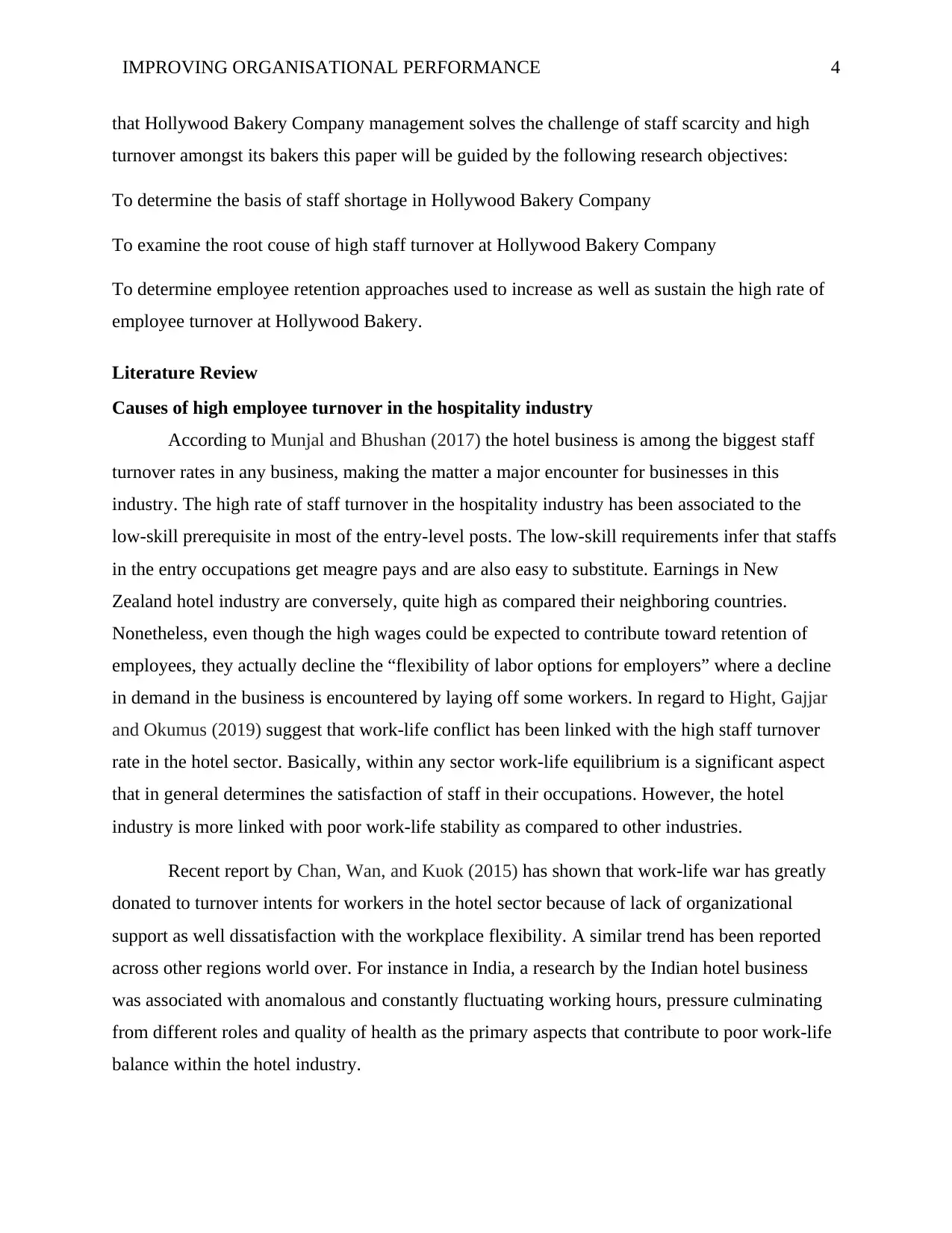
IMPROVING ORGANISATIONAL PERFORMANCE 4
that Hollywood Bakery Company management solves the challenge of staff scarcity and high
turnover amongst its bakers this paper will be guided by the following research objectives:
To determine the basis of staff shortage in Hollywood Bakery Company
To examine the root couse of high staff turnover at Hollywood Bakery Company
To determine employee retention approaches used to increase as well as sustain the high rate of
employee turnover at Hollywood Bakery.
Literature Review
Causes of high employee turnover in the hospitality industry
According to Munjal and Bhushan (2017) the hotel business is among the biggest staff
turnover rates in any business, making the matter a major encounter for businesses in this
industry. The high rate of staff turnover in the hospitality industry has been associated to the
low-skill prerequisite in most of the entry-level posts. The low-skill requirements infer that staffs
in the entry occupations get meagre pays and are also easy to substitute. Earnings in New
Zealand hotel industry are conversely, quite high as compared their neighboring countries.
Nonetheless, even though the high wages could be expected to contribute toward retention of
employees, they actually decline the “flexibility of labor options for employers” where a decline
in demand in the business is encountered by laying off some workers. In regard to Hight, Gajjar
and Okumus (2019) suggest that work-life conflict has been linked with the high staff turnover
rate in the hotel sector. Basically, within any sector work-life equilibrium is a significant aspect
that in general determines the satisfaction of staff in their occupations. However, the hotel
industry is more linked with poor work-life stability as compared to other industries.
Recent report by Chan, Wan, and Kuok (2015) has shown that work-life war has greatly
donated to turnover intents for workers in the hotel sector because of lack of organizational
support as well dissatisfaction with the workplace flexibility. A similar trend has been reported
across other regions world over. For instance in India, a research by the Indian hotel business
was associated with anomalous and constantly fluctuating working hours, pressure culminating
from different roles and quality of health as the primary aspects that contribute to poor work-life
balance within the hotel industry.
that Hollywood Bakery Company management solves the challenge of staff scarcity and high
turnover amongst its bakers this paper will be guided by the following research objectives:
To determine the basis of staff shortage in Hollywood Bakery Company
To examine the root couse of high staff turnover at Hollywood Bakery Company
To determine employee retention approaches used to increase as well as sustain the high rate of
employee turnover at Hollywood Bakery.
Literature Review
Causes of high employee turnover in the hospitality industry
According to Munjal and Bhushan (2017) the hotel business is among the biggest staff
turnover rates in any business, making the matter a major encounter for businesses in this
industry. The high rate of staff turnover in the hospitality industry has been associated to the
low-skill prerequisite in most of the entry-level posts. The low-skill requirements infer that staffs
in the entry occupations get meagre pays and are also easy to substitute. Earnings in New
Zealand hotel industry are conversely, quite high as compared their neighboring countries.
Nonetheless, even though the high wages could be expected to contribute toward retention of
employees, they actually decline the “flexibility of labor options for employers” where a decline
in demand in the business is encountered by laying off some workers. In regard to Hight, Gajjar
and Okumus (2019) suggest that work-life conflict has been linked with the high staff turnover
rate in the hotel sector. Basically, within any sector work-life equilibrium is a significant aspect
that in general determines the satisfaction of staff in their occupations. However, the hotel
industry is more linked with poor work-life stability as compared to other industries.
Recent report by Chan, Wan, and Kuok (2015) has shown that work-life war has greatly
donated to turnover intents for workers in the hotel sector because of lack of organizational
support as well dissatisfaction with the workplace flexibility. A similar trend has been reported
across other regions world over. For instance in India, a research by the Indian hotel business
was associated with anomalous and constantly fluctuating working hours, pressure culminating
from different roles and quality of health as the primary aspects that contribute to poor work-life
balance within the hotel industry.
Paraphrase This Document
Need a fresh take? Get an instant paraphrase of this document with our AI Paraphraser
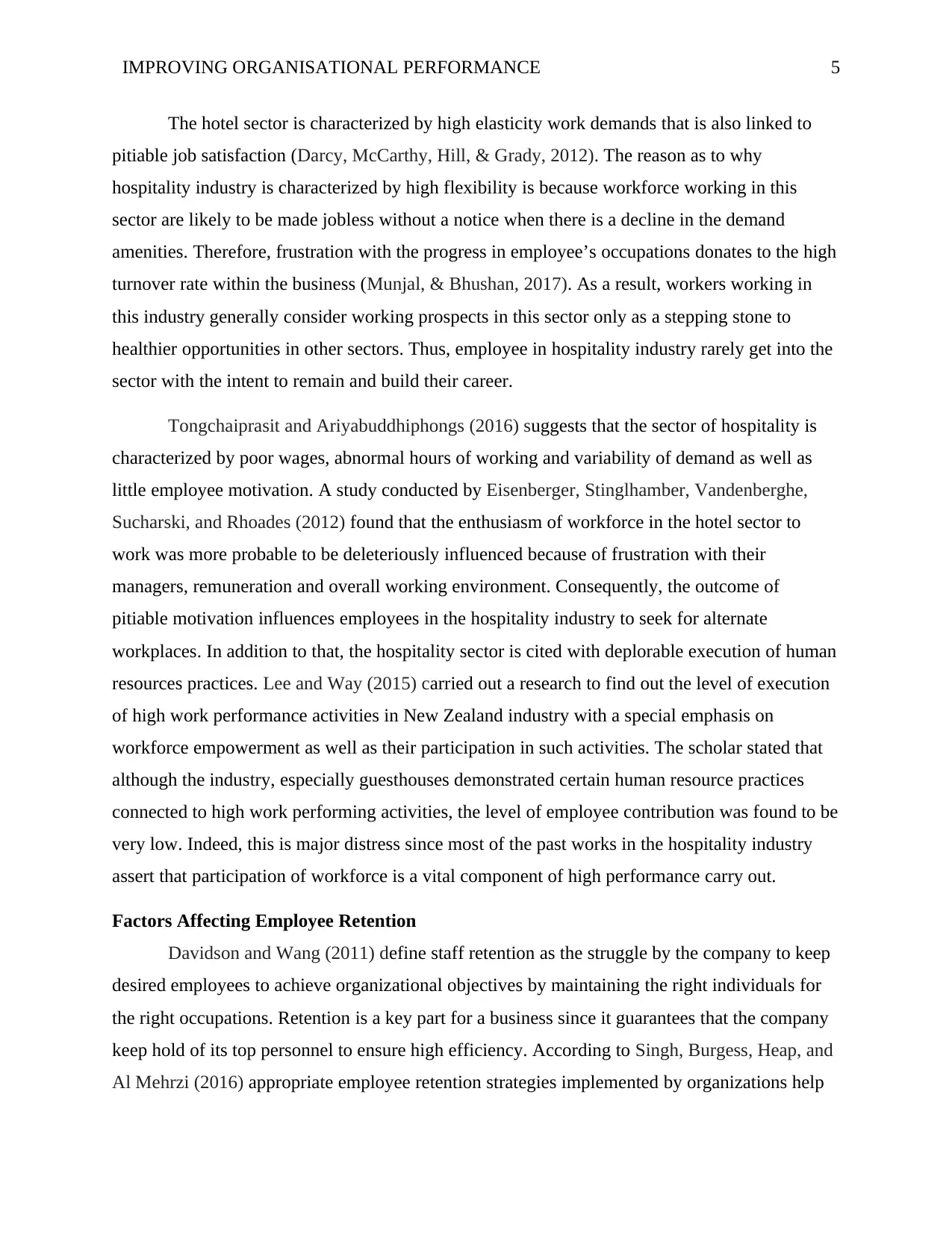
IMPROVING ORGANISATIONAL PERFORMANCE 5
The hotel sector is characterized by high elasticity work demands that is also linked to
pitiable job satisfaction (Darcy, McCarthy, Hill, & Grady, 2012). The reason as to why
hospitality industry is characterized by high flexibility is because workforce working in this
sector are likely to be made jobless without a notice when there is a decline in the demand
amenities. Therefore, frustration with the progress in employee’s occupations donates to the high
turnover rate within the business (Munjal, & Bhushan, 2017). As a result, workers working in
this industry generally consider working prospects in this sector only as a stepping stone to
healthier opportunities in other sectors. Thus, employee in hospitality industry rarely get into the
sector with the intent to remain and build their career.
Tongchaiprasit and Ariyabuddhiphongs (2016) suggests that the sector of hospitality is
characterized by poor wages, abnormal hours of working and variability of demand as well as
little employee motivation. A study conducted by Eisenberger, Stinglhamber, Vandenberghe,
Sucharski, and Rhoades (2012) found that the enthusiasm of workforce in the hotel sector to
work was more probable to be deleteriously influenced because of frustration with their
managers, remuneration and overall working environment. Consequently, the outcome of
pitiable motivation influences employees in the hospitality industry to seek for alternate
workplaces. In addition to that, the hospitality sector is cited with deplorable execution of human
resources practices. Lee and Way (2015) carried out a research to find out the level of execution
of high work performance activities in New Zealand industry with a special emphasis on
workforce empowerment as well as their participation in such activities. The scholar stated that
although the industry, especially guesthouses demonstrated certain human resource practices
connected to high work performing activities, the level of employee contribution was found to be
very low. Indeed, this is major distress since most of the past works in the hospitality industry
assert that participation of workforce is a vital component of high performance carry out.
Factors Affecting Employee Retention
Davidson and Wang (2011) define staff retention as the struggle by the company to keep
desired employees to achieve organizational objectives by maintaining the right individuals for
the right occupations. Retention is a key part for a business since it guarantees that the company
keep hold of its top personnel to ensure high efficiency. According to Singh, Burgess, Heap, and
Al Mehrzi (2016) appropriate employee retention strategies implemented by organizations help
The hotel sector is characterized by high elasticity work demands that is also linked to
pitiable job satisfaction (Darcy, McCarthy, Hill, & Grady, 2012). The reason as to why
hospitality industry is characterized by high flexibility is because workforce working in this
sector are likely to be made jobless without a notice when there is a decline in the demand
amenities. Therefore, frustration with the progress in employee’s occupations donates to the high
turnover rate within the business (Munjal, & Bhushan, 2017). As a result, workers working in
this industry generally consider working prospects in this sector only as a stepping stone to
healthier opportunities in other sectors. Thus, employee in hospitality industry rarely get into the
sector with the intent to remain and build their career.
Tongchaiprasit and Ariyabuddhiphongs (2016) suggests that the sector of hospitality is
characterized by poor wages, abnormal hours of working and variability of demand as well as
little employee motivation. A study conducted by Eisenberger, Stinglhamber, Vandenberghe,
Sucharski, and Rhoades (2012) found that the enthusiasm of workforce in the hotel sector to
work was more probable to be deleteriously influenced because of frustration with their
managers, remuneration and overall working environment. Consequently, the outcome of
pitiable motivation influences employees in the hospitality industry to seek for alternate
workplaces. In addition to that, the hospitality sector is cited with deplorable execution of human
resources practices. Lee and Way (2015) carried out a research to find out the level of execution
of high work performance activities in New Zealand industry with a special emphasis on
workforce empowerment as well as their participation in such activities. The scholar stated that
although the industry, especially guesthouses demonstrated certain human resource practices
connected to high work performing activities, the level of employee contribution was found to be
very low. Indeed, this is major distress since most of the past works in the hospitality industry
assert that participation of workforce is a vital component of high performance carry out.
Factors Affecting Employee Retention
Davidson and Wang (2011) define staff retention as the struggle by the company to keep
desired employees to achieve organizational objectives by maintaining the right individuals for
the right occupations. Retention is a key part for a business since it guarantees that the company
keep hold of its top personnel to ensure high efficiency. According to Singh, Burgess, Heap, and
Al Mehrzi (2016) appropriate employee retention strategies implemented by organizations help
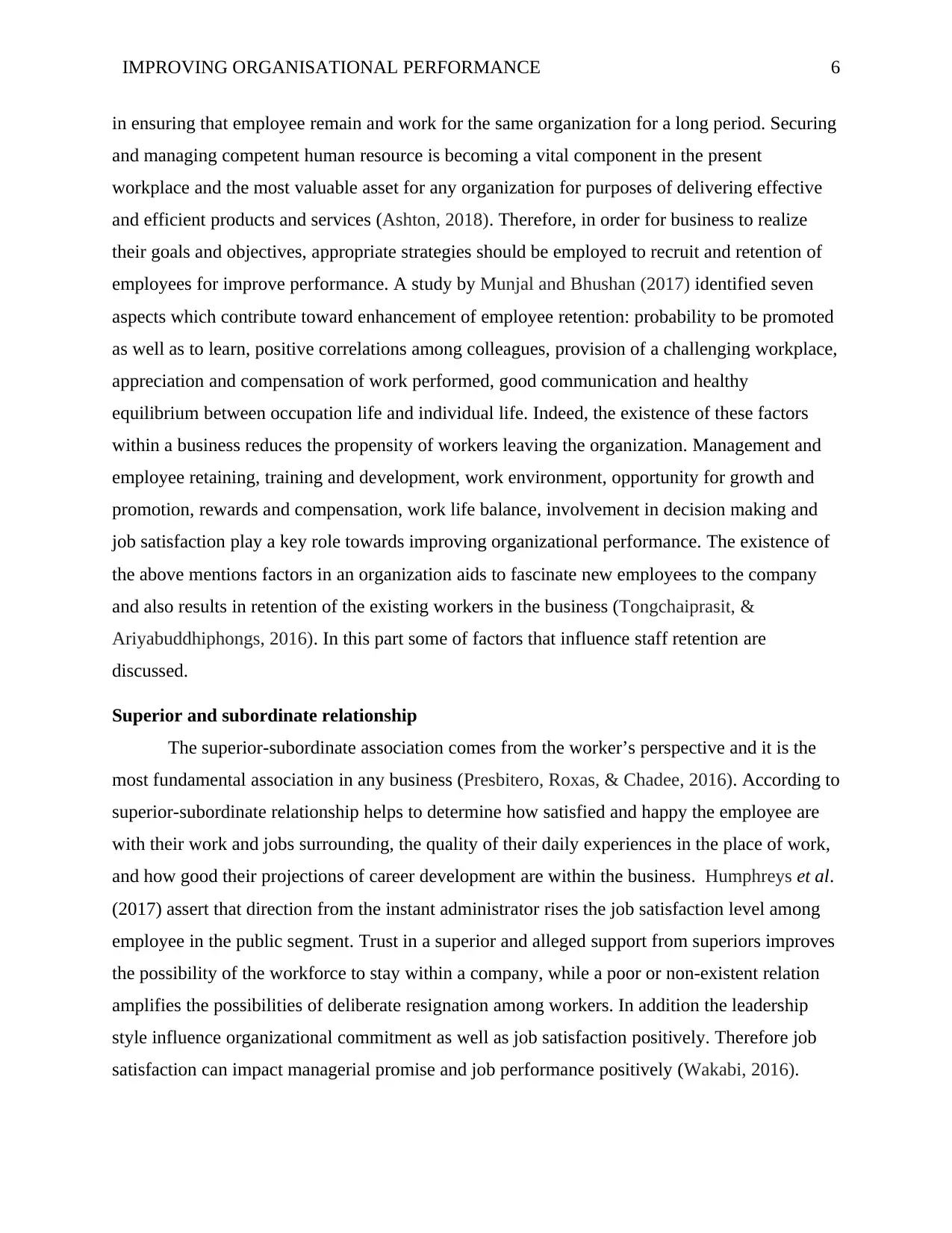
IMPROVING ORGANISATIONAL PERFORMANCE 6
in ensuring that employee remain and work for the same organization for a long period. Securing
and managing competent human resource is becoming a vital component in the present
workplace and the most valuable asset for any organization for purposes of delivering effective
and efficient products and services (Ashton, 2018). Therefore, in order for business to realize
their goals and objectives, appropriate strategies should be employed to recruit and retention of
employees for improve performance. A study by Munjal and Bhushan (2017) identified seven
aspects which contribute toward enhancement of employee retention: probability to be promoted
as well as to learn, positive correlations among colleagues, provision of a challenging workplace,
appreciation and compensation of work performed, good communication and healthy
equilibrium between occupation life and individual life. Indeed, the existence of these factors
within a business reduces the propensity of workers leaving the organization. Management and
employee retaining, training and development, work environment, opportunity for growth and
promotion, rewards and compensation, work life balance, involvement in decision making and
job satisfaction play a key role towards improving organizational performance. The existence of
the above mentions factors in an organization aids to fascinate new employees to the company
and also results in retention of the existing workers in the business (Tongchaiprasit, &
Ariyabuddhiphongs, 2016). In this part some of factors that influence staff retention are
discussed.
Superior and subordinate relationship
The superior-subordinate association comes from the worker’s perspective and it is the
most fundamental association in any business (Presbitero, Roxas, & Chadee, 2016). According to
superior-subordinate relationship helps to determine how satisfied and happy the employee are
with their work and jobs surrounding, the quality of their daily experiences in the place of work,
and how good their projections of career development are within the business. Humphreys et al.
(2017) assert that direction from the instant administrator rises the job satisfaction level among
employee in the public segment. Trust in a superior and alleged support from superiors improves
the possibility of the workforce to stay within a company, while a poor or non-existent relation
amplifies the possibilities of deliberate resignation among workers. In addition the leadership
style influence organizational commitment as well as job satisfaction positively. Therefore job
satisfaction can impact managerial promise and job performance positively (Wakabi, 2016).
in ensuring that employee remain and work for the same organization for a long period. Securing
and managing competent human resource is becoming a vital component in the present
workplace and the most valuable asset for any organization for purposes of delivering effective
and efficient products and services (Ashton, 2018). Therefore, in order for business to realize
their goals and objectives, appropriate strategies should be employed to recruit and retention of
employees for improve performance. A study by Munjal and Bhushan (2017) identified seven
aspects which contribute toward enhancement of employee retention: probability to be promoted
as well as to learn, positive correlations among colleagues, provision of a challenging workplace,
appreciation and compensation of work performed, good communication and healthy
equilibrium between occupation life and individual life. Indeed, the existence of these factors
within a business reduces the propensity of workers leaving the organization. Management and
employee retaining, training and development, work environment, opportunity for growth and
promotion, rewards and compensation, work life balance, involvement in decision making and
job satisfaction play a key role towards improving organizational performance. The existence of
the above mentions factors in an organization aids to fascinate new employees to the company
and also results in retention of the existing workers in the business (Tongchaiprasit, &
Ariyabuddhiphongs, 2016). In this part some of factors that influence staff retention are
discussed.
Superior and subordinate relationship
The superior-subordinate association comes from the worker’s perspective and it is the
most fundamental association in any business (Presbitero, Roxas, & Chadee, 2016). According to
superior-subordinate relationship helps to determine how satisfied and happy the employee are
with their work and jobs surrounding, the quality of their daily experiences in the place of work,
and how good their projections of career development are within the business. Humphreys et al.
(2017) assert that direction from the instant administrator rises the job satisfaction level among
employee in the public segment. Trust in a superior and alleged support from superiors improves
the possibility of the workforce to stay within a company, while a poor or non-existent relation
amplifies the possibilities of deliberate resignation among workers. In addition the leadership
style influence organizational commitment as well as job satisfaction positively. Therefore job
satisfaction can impact managerial promise and job performance positively (Wakabi, 2016).
⊘ This is a preview!⊘
Do you want full access?
Subscribe today to unlock all pages.

Trusted by 1+ million students worldwide
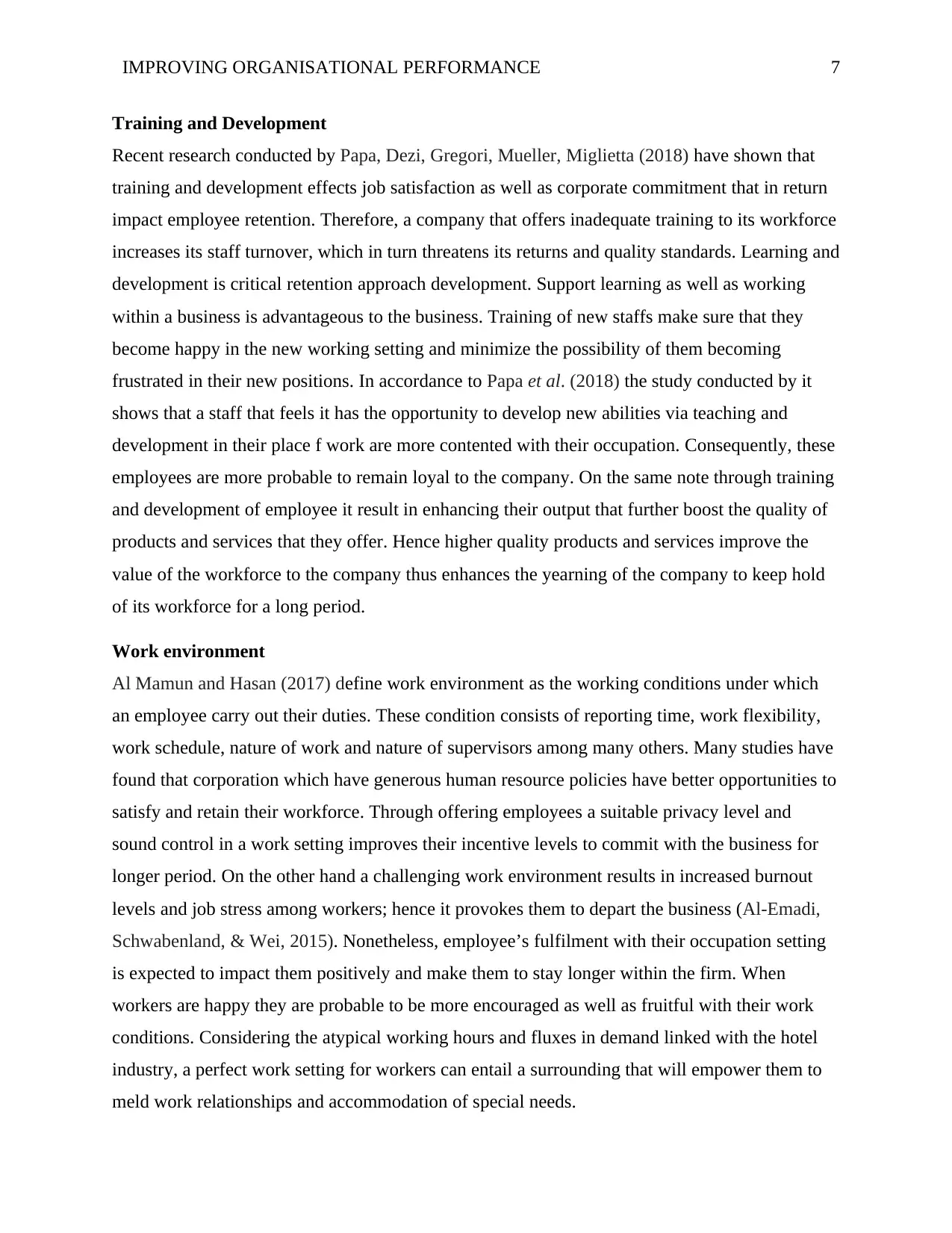
IMPROVING ORGANISATIONAL PERFORMANCE 7
Training and Development
Recent research conducted by Papa, Dezi, Gregori, Mueller, Miglietta (2018) have shown that
training and development effects job satisfaction as well as corporate commitment that in return
impact employee retention. Therefore, a company that offers inadequate training to its workforce
increases its staff turnover, which in turn threatens its returns and quality standards. Learning and
development is critical retention approach development. Support learning as well as working
within a business is advantageous to the business. Training of new staffs make sure that they
become happy in the new working setting and minimize the possibility of them becoming
frustrated in their new positions. In accordance to Papa et al. (2018) the study conducted by it
shows that a staff that feels it has the opportunity to develop new abilities via teaching and
development in their place f work are more contented with their occupation. Consequently, these
employees are more probable to remain loyal to the company. On the same note through training
and development of employee it result in enhancing their output that further boost the quality of
products and services that they offer. Hence higher quality products and services improve the
value of the workforce to the company thus enhances the yearning of the company to keep hold
of its workforce for a long period.
Work environment
Al Mamun and Hasan (2017) define work environment as the working conditions under which
an employee carry out their duties. These condition consists of reporting time, work flexibility,
work schedule, nature of work and nature of supervisors among many others. Many studies have
found that corporation which have generous human resource policies have better opportunities to
satisfy and retain their workforce. Through offering employees a suitable privacy level and
sound control in a work setting improves their incentive levels to commit with the business for
longer period. On the other hand a challenging work environment results in increased burnout
levels and job stress among workers; hence it provokes them to depart the business (Al-Emadi,
Schwabenland, & Wei, 2015). Nonetheless, employee’s fulfilment with their occupation setting
is expected to impact them positively and make them to stay longer within the firm. When
workers are happy they are probable to be more encouraged as well as fruitful with their work
conditions. Considering the atypical working hours and fluxes in demand linked with the hotel
industry, a perfect work setting for workers can entail a surrounding that will empower them to
meld work relationships and accommodation of special needs.
Training and Development
Recent research conducted by Papa, Dezi, Gregori, Mueller, Miglietta (2018) have shown that
training and development effects job satisfaction as well as corporate commitment that in return
impact employee retention. Therefore, a company that offers inadequate training to its workforce
increases its staff turnover, which in turn threatens its returns and quality standards. Learning and
development is critical retention approach development. Support learning as well as working
within a business is advantageous to the business. Training of new staffs make sure that they
become happy in the new working setting and minimize the possibility of them becoming
frustrated in their new positions. In accordance to Papa et al. (2018) the study conducted by it
shows that a staff that feels it has the opportunity to develop new abilities via teaching and
development in their place f work are more contented with their occupation. Consequently, these
employees are more probable to remain loyal to the company. On the same note through training
and development of employee it result in enhancing their output that further boost the quality of
products and services that they offer. Hence higher quality products and services improve the
value of the workforce to the company thus enhances the yearning of the company to keep hold
of its workforce for a long period.
Work environment
Al Mamun and Hasan (2017) define work environment as the working conditions under which
an employee carry out their duties. These condition consists of reporting time, work flexibility,
work schedule, nature of work and nature of supervisors among many others. Many studies have
found that corporation which have generous human resource policies have better opportunities to
satisfy and retain their workforce. Through offering employees a suitable privacy level and
sound control in a work setting improves their incentive levels to commit with the business for
longer period. On the other hand a challenging work environment results in increased burnout
levels and job stress among workers; hence it provokes them to depart the business (Al-Emadi,
Schwabenland, & Wei, 2015). Nonetheless, employee’s fulfilment with their occupation setting
is expected to impact them positively and make them to stay longer within the firm. When
workers are happy they are probable to be more encouraged as well as fruitful with their work
conditions. Considering the atypical working hours and fluxes in demand linked with the hotel
industry, a perfect work setting for workers can entail a surrounding that will empower them to
meld work relationships and accommodation of special needs.
Paraphrase This Document
Need a fresh take? Get an instant paraphrase of this document with our AI Paraphraser
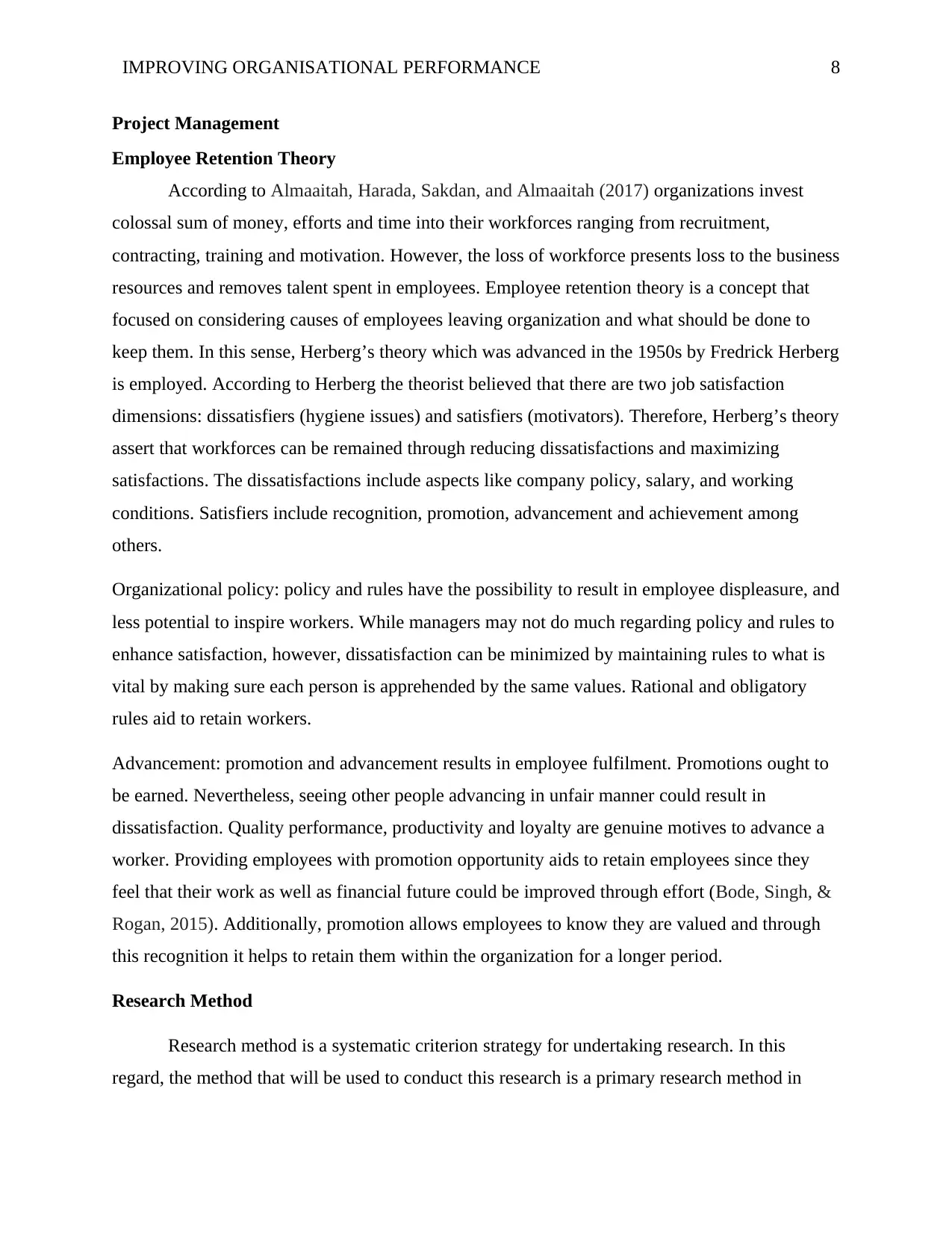
IMPROVING ORGANISATIONAL PERFORMANCE 8
Project Management
Employee Retention Theory
According to Almaaitah, Harada, Sakdan, and Almaaitah (2017) organizations invest
colossal sum of money, efforts and time into their workforces ranging from recruitment,
contracting, training and motivation. However, the loss of workforce presents loss to the business
resources and removes talent spent in employees. Employee retention theory is a concept that
focused on considering causes of employees leaving organization and what should be done to
keep them. In this sense, Herberg’s theory which was advanced in the 1950s by Fredrick Herberg
is employed. According to Herberg the theorist believed that there are two job satisfaction
dimensions: dissatisfiers (hygiene issues) and satisfiers (motivators). Therefore, Herberg’s theory
assert that workforces can be remained through reducing dissatisfactions and maximizing
satisfactions. The dissatisfactions include aspects like company policy, salary, and working
conditions. Satisfiers include recognition, promotion, advancement and achievement among
others.
Organizational policy: policy and rules have the possibility to result in employee displeasure, and
less potential to inspire workers. While managers may not do much regarding policy and rules to
enhance satisfaction, however, dissatisfaction can be minimized by maintaining rules to what is
vital by making sure each person is apprehended by the same values. Rational and obligatory
rules aid to retain workers.
Advancement: promotion and advancement results in employee fulfilment. Promotions ought to
be earned. Nevertheless, seeing other people advancing in unfair manner could result in
dissatisfaction. Quality performance, productivity and loyalty are genuine motives to advance a
worker. Providing employees with promotion opportunity aids to retain employees since they
feel that their work as well as financial future could be improved through effort (Bode, Singh, &
Rogan, 2015). Additionally, promotion allows employees to know they are valued and through
this recognition it helps to retain them within the organization for a longer period.
Research Method
Research method is a systematic criterion strategy for undertaking research. In this
regard, the method that will be used to conduct this research is a primary research method in
Project Management
Employee Retention Theory
According to Almaaitah, Harada, Sakdan, and Almaaitah (2017) organizations invest
colossal sum of money, efforts and time into their workforces ranging from recruitment,
contracting, training and motivation. However, the loss of workforce presents loss to the business
resources and removes talent spent in employees. Employee retention theory is a concept that
focused on considering causes of employees leaving organization and what should be done to
keep them. In this sense, Herberg’s theory which was advanced in the 1950s by Fredrick Herberg
is employed. According to Herberg the theorist believed that there are two job satisfaction
dimensions: dissatisfiers (hygiene issues) and satisfiers (motivators). Therefore, Herberg’s theory
assert that workforces can be remained through reducing dissatisfactions and maximizing
satisfactions. The dissatisfactions include aspects like company policy, salary, and working
conditions. Satisfiers include recognition, promotion, advancement and achievement among
others.
Organizational policy: policy and rules have the possibility to result in employee displeasure, and
less potential to inspire workers. While managers may not do much regarding policy and rules to
enhance satisfaction, however, dissatisfaction can be minimized by maintaining rules to what is
vital by making sure each person is apprehended by the same values. Rational and obligatory
rules aid to retain workers.
Advancement: promotion and advancement results in employee fulfilment. Promotions ought to
be earned. Nevertheless, seeing other people advancing in unfair manner could result in
dissatisfaction. Quality performance, productivity and loyalty are genuine motives to advance a
worker. Providing employees with promotion opportunity aids to retain employees since they
feel that their work as well as financial future could be improved through effort (Bode, Singh, &
Rogan, 2015). Additionally, promotion allows employees to know they are valued and through
this recognition it helps to retain them within the organization for a longer period.
Research Method
Research method is a systematic criterion strategy for undertaking research. In this
regard, the method that will be used to conduct this research is a primary research method in
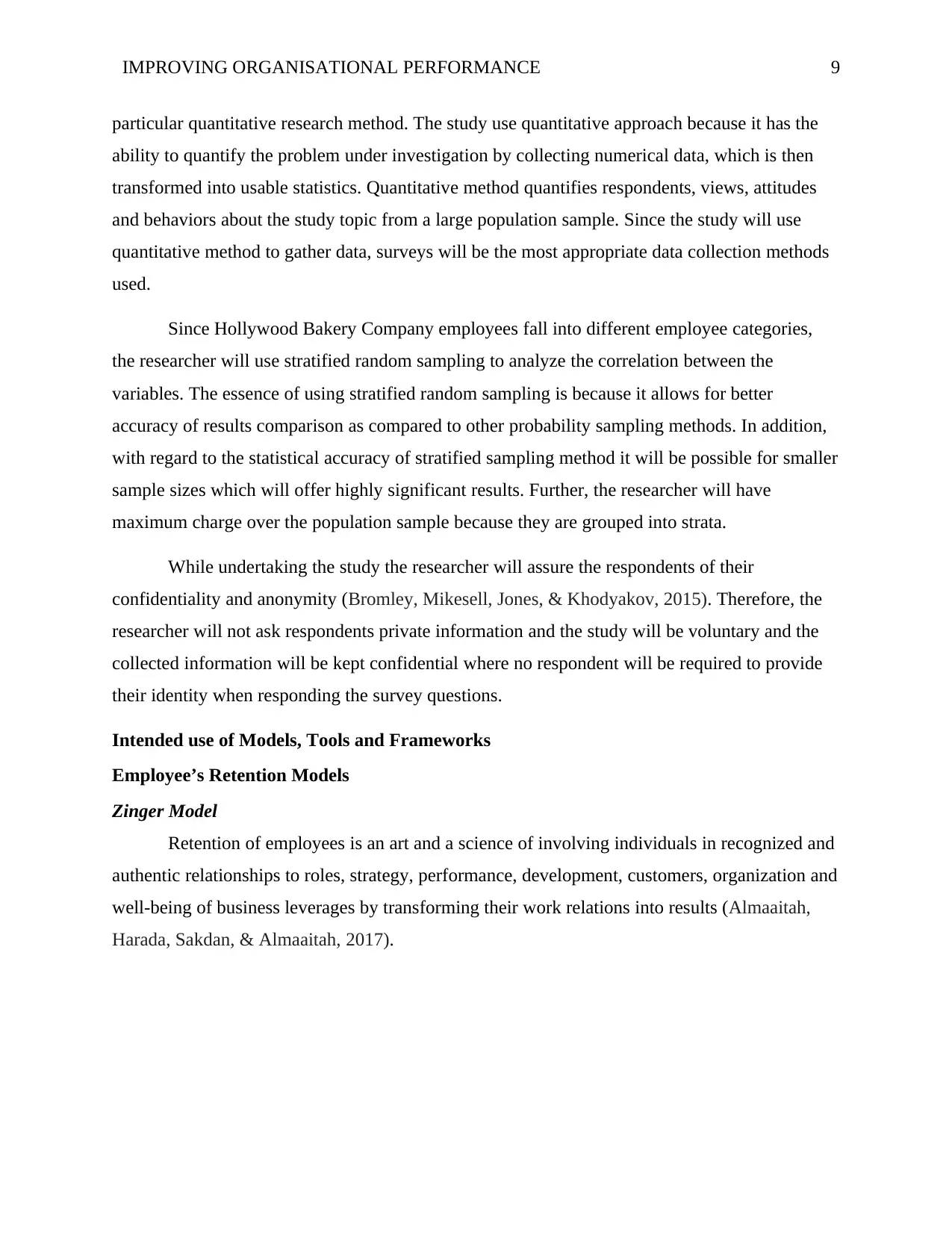
IMPROVING ORGANISATIONAL PERFORMANCE 9
particular quantitative research method. The study use quantitative approach because it has the
ability to quantify the problem under investigation by collecting numerical data, which is then
transformed into usable statistics. Quantitative method quantifies respondents, views, attitudes
and behaviors about the study topic from a large population sample. Since the study will use
quantitative method to gather data, surveys will be the most appropriate data collection methods
used.
Since Hollywood Bakery Company employees fall into different employee categories,
the researcher will use stratified random sampling to analyze the correlation between the
variables. The essence of using stratified random sampling is because it allows for better
accuracy of results comparison as compared to other probability sampling methods. In addition,
with regard to the statistical accuracy of stratified sampling method it will be possible for smaller
sample sizes which will offer highly significant results. Further, the researcher will have
maximum charge over the population sample because they are grouped into strata.
While undertaking the study the researcher will assure the respondents of their
confidentiality and anonymity (Bromley, Mikesell, Jones, & Khodyakov, 2015). Therefore, the
researcher will not ask respondents private information and the study will be voluntary and the
collected information will be kept confidential where no respondent will be required to provide
their identity when responding the survey questions.
Intended use of Models, Tools and Frameworks
Employee’s Retention Models
Zinger Model
Retention of employees is an art and a science of involving individuals in recognized and
authentic relationships to roles, strategy, performance, development, customers, organization and
well-being of business leverages by transforming their work relations into results (Almaaitah,
Harada, Sakdan, & Almaaitah, 2017).
particular quantitative research method. The study use quantitative approach because it has the
ability to quantify the problem under investigation by collecting numerical data, which is then
transformed into usable statistics. Quantitative method quantifies respondents, views, attitudes
and behaviors about the study topic from a large population sample. Since the study will use
quantitative method to gather data, surveys will be the most appropriate data collection methods
used.
Since Hollywood Bakery Company employees fall into different employee categories,
the researcher will use stratified random sampling to analyze the correlation between the
variables. The essence of using stratified random sampling is because it allows for better
accuracy of results comparison as compared to other probability sampling methods. In addition,
with regard to the statistical accuracy of stratified sampling method it will be possible for smaller
sample sizes which will offer highly significant results. Further, the researcher will have
maximum charge over the population sample because they are grouped into strata.
While undertaking the study the researcher will assure the respondents of their
confidentiality and anonymity (Bromley, Mikesell, Jones, & Khodyakov, 2015). Therefore, the
researcher will not ask respondents private information and the study will be voluntary and the
collected information will be kept confidential where no respondent will be required to provide
their identity when responding the survey questions.
Intended use of Models, Tools and Frameworks
Employee’s Retention Models
Zinger Model
Retention of employees is an art and a science of involving individuals in recognized and
authentic relationships to roles, strategy, performance, development, customers, organization and
well-being of business leverages by transforming their work relations into results (Almaaitah,
Harada, Sakdan, & Almaaitah, 2017).
⊘ This is a preview!⊘
Do you want full access?
Subscribe today to unlock all pages.

Trusted by 1+ million students worldwide
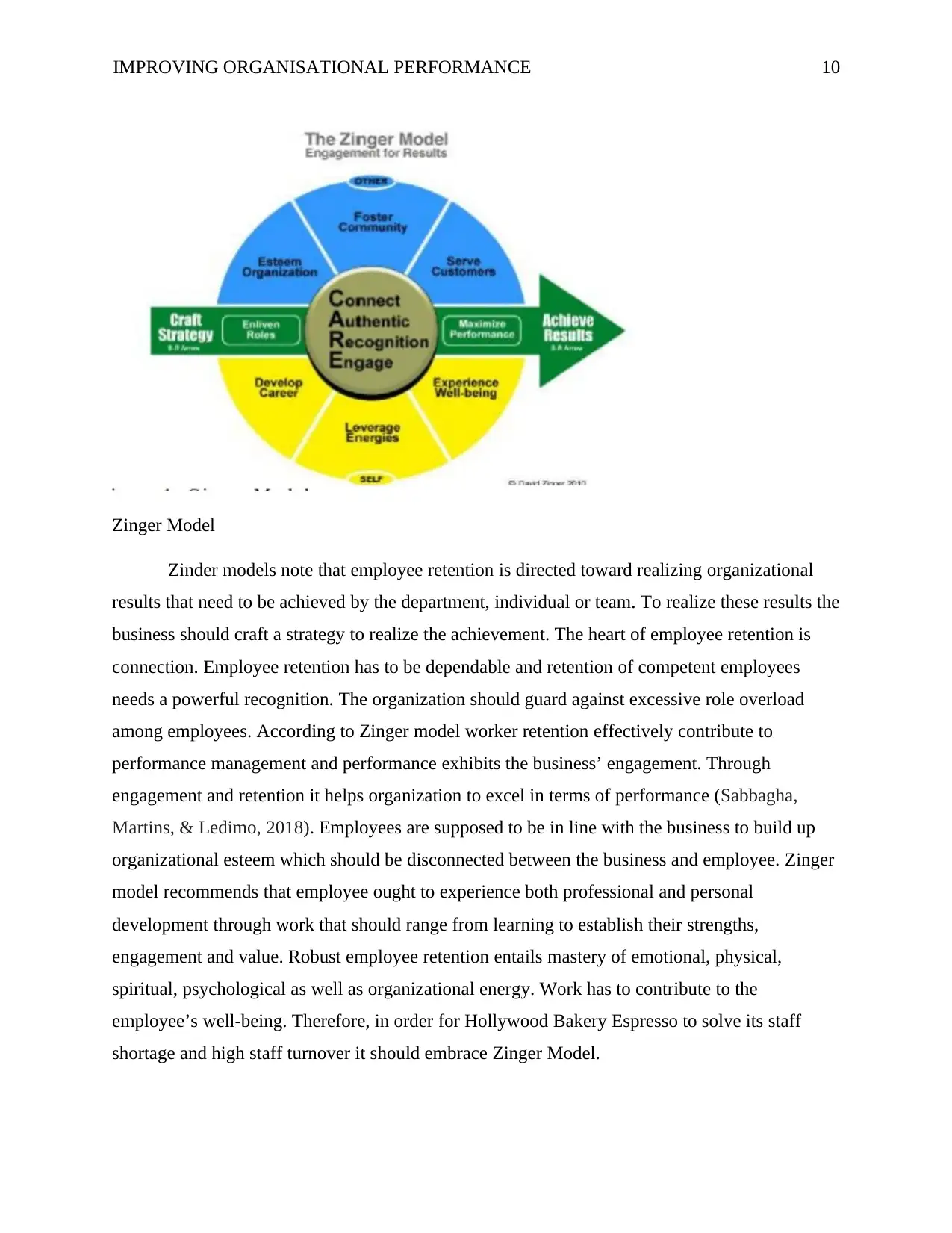
IMPROVING ORGANISATIONAL PERFORMANCE 10
Zinger Model
Zinder models note that employee retention is directed toward realizing organizational
results that need to be achieved by the department, individual or team. To realize these results the
business should craft a strategy to realize the achievement. The heart of employee retention is
connection. Employee retention has to be dependable and retention of competent employees
needs a powerful recognition. The organization should guard against excessive role overload
among employees. According to Zinger model worker retention effectively contribute to
performance management and performance exhibits the business’ engagement. Through
engagement and retention it helps organization to excel in terms of performance (Sabbagha,
Martins, & Ledimo, 2018). Employees are supposed to be in line with the business to build up
organizational esteem which should be disconnected between the business and employee. Zinger
model recommends that employee ought to experience both professional and personal
development through work that should range from learning to establish their strengths,
engagement and value. Robust employee retention entails mastery of emotional, physical,
spiritual, psychological as well as organizational energy. Work has to contribute to the
employee’s well-being. Therefore, in order for Hollywood Bakery Espresso to solve its staff
shortage and high staff turnover it should embrace Zinger Model.
Zinger Model
Zinder models note that employee retention is directed toward realizing organizational
results that need to be achieved by the department, individual or team. To realize these results the
business should craft a strategy to realize the achievement. The heart of employee retention is
connection. Employee retention has to be dependable and retention of competent employees
needs a powerful recognition. The organization should guard against excessive role overload
among employees. According to Zinger model worker retention effectively contribute to
performance management and performance exhibits the business’ engagement. Through
engagement and retention it helps organization to excel in terms of performance (Sabbagha,
Martins, & Ledimo, 2018). Employees are supposed to be in line with the business to build up
organizational esteem which should be disconnected between the business and employee. Zinger
model recommends that employee ought to experience both professional and personal
development through work that should range from learning to establish their strengths,
engagement and value. Robust employee retention entails mastery of emotional, physical,
spiritual, psychological as well as organizational energy. Work has to contribute to the
employee’s well-being. Therefore, in order for Hollywood Bakery Espresso to solve its staff
shortage and high staff turnover it should embrace Zinger Model.
Paraphrase This Document
Need a fresh take? Get an instant paraphrase of this document with our AI Paraphraser
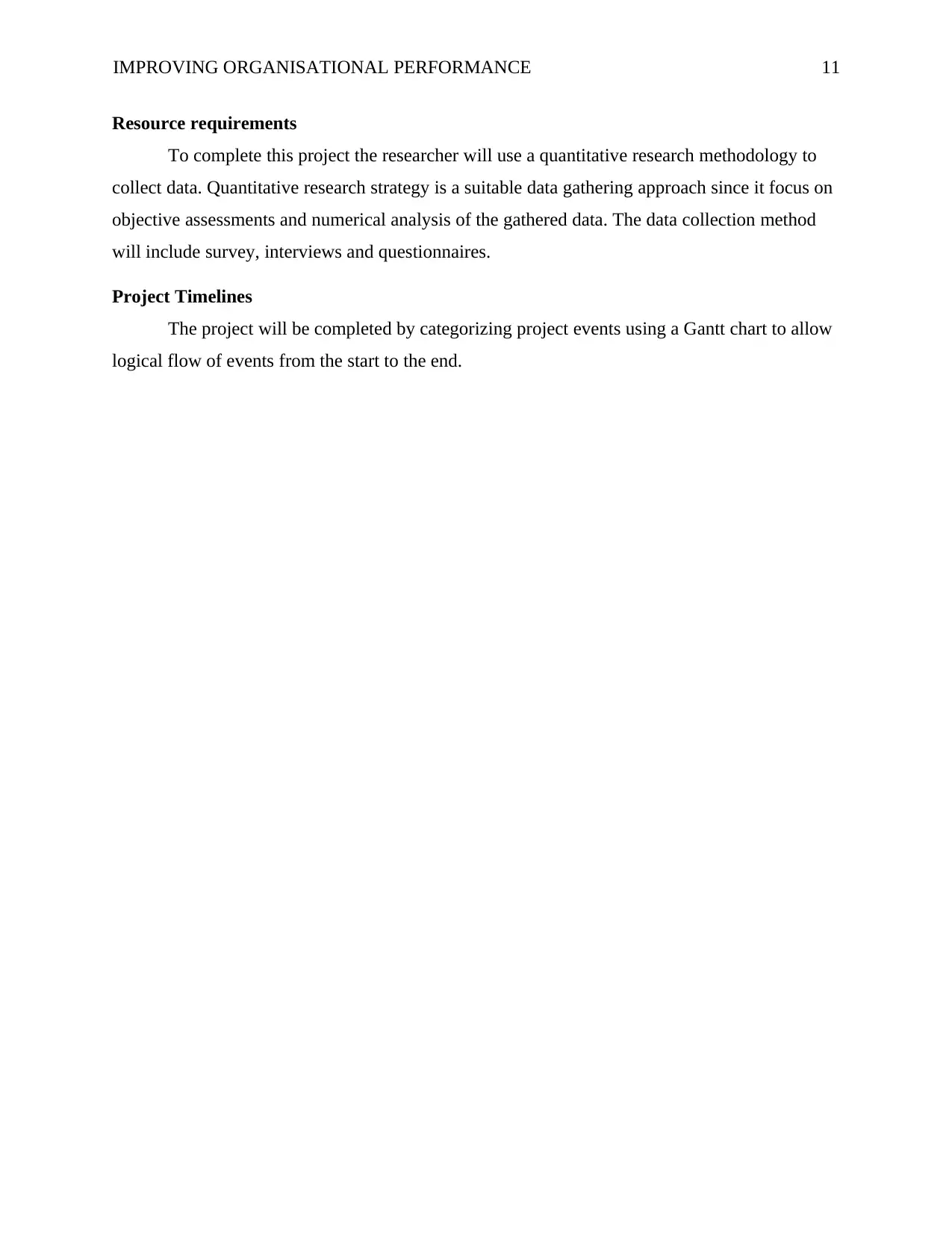
IMPROVING ORGANISATIONAL PERFORMANCE 11
Resource requirements
To complete this project the researcher will use a quantitative research methodology to
collect data. Quantitative research strategy is a suitable data gathering approach since it focus on
objective assessments and numerical analysis of the gathered data. The data collection method
will include survey, interviews and questionnaires.
Project Timelines
The project will be completed by categorizing project events using a Gantt chart to allow
logical flow of events from the start to the end.
Resource requirements
To complete this project the researcher will use a quantitative research methodology to
collect data. Quantitative research strategy is a suitable data gathering approach since it focus on
objective assessments and numerical analysis of the gathered data. The data collection method
will include survey, interviews and questionnaires.
Project Timelines
The project will be completed by categorizing project events using a Gantt chart to allow
logical flow of events from the start to the end.
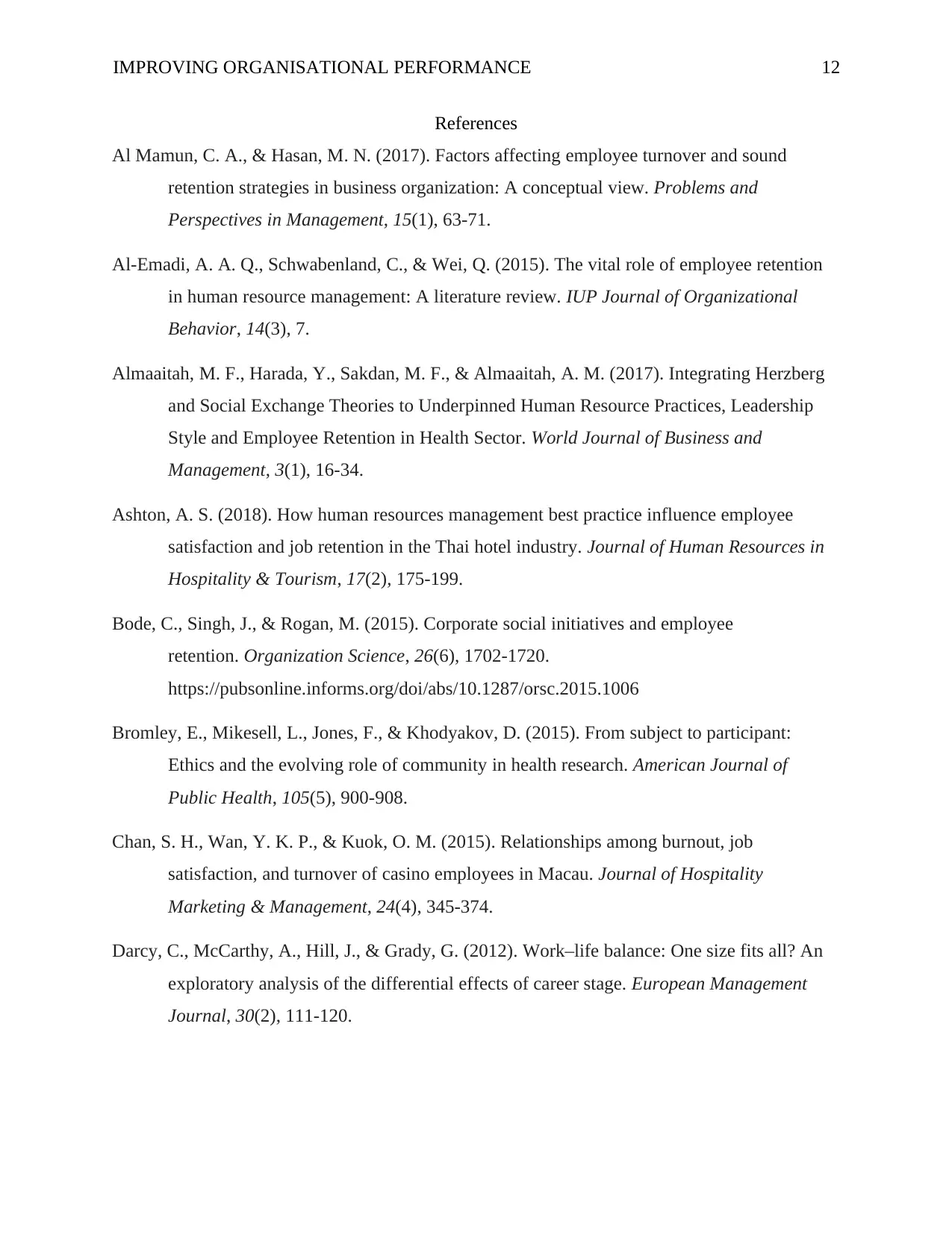
IMPROVING ORGANISATIONAL PERFORMANCE 12
References
Al Mamun, C. A., & Hasan, M. N. (2017). Factors affecting employee turnover and sound
retention strategies in business organization: A conceptual view. Problems and
Perspectives in Management, 15(1), 63-71.
Al-Emadi, A. A. Q., Schwabenland, C., & Wei, Q. (2015). The vital role of employee retention
in human resource management: A literature review. IUP Journal of Organizational
Behavior, 14(3), 7.
Almaaitah, M. F., Harada, Y., Sakdan, M. F., & Almaaitah, A. M. (2017). Integrating Herzberg
and Social Exchange Theories to Underpinned Human Resource Practices, Leadership
Style and Employee Retention in Health Sector. World Journal of Business and
Management, 3(1), 16-34.
Ashton, A. S. (2018). How human resources management best practice influence employee
satisfaction and job retention in the Thai hotel industry. Journal of Human Resources in
Hospitality & Tourism, 17(2), 175-199.
Bode, C., Singh, J., & Rogan, M. (2015). Corporate social initiatives and employee
retention. Organization Science, 26(6), 1702-1720.
https://pubsonline.informs.org/doi/abs/10.1287/orsc.2015.1006
Bromley, E., Mikesell, L., Jones, F., & Khodyakov, D. (2015). From subject to participant:
Ethics and the evolving role of community in health research. American Journal of
Public Health, 105(5), 900-908.
Chan, S. H., Wan, Y. K. P., & Kuok, O. M. (2015). Relationships among burnout, job
satisfaction, and turnover of casino employees in Macau. Journal of Hospitality
Marketing & Management, 24(4), 345-374.
Darcy, C., McCarthy, A., Hill, J., & Grady, G. (2012). Work–life balance: One size fits all? An
exploratory analysis of the differential effects of career stage. European Management
Journal, 30(2), 111-120.
References
Al Mamun, C. A., & Hasan, M. N. (2017). Factors affecting employee turnover and sound
retention strategies in business organization: A conceptual view. Problems and
Perspectives in Management, 15(1), 63-71.
Al-Emadi, A. A. Q., Schwabenland, C., & Wei, Q. (2015). The vital role of employee retention
in human resource management: A literature review. IUP Journal of Organizational
Behavior, 14(3), 7.
Almaaitah, M. F., Harada, Y., Sakdan, M. F., & Almaaitah, A. M. (2017). Integrating Herzberg
and Social Exchange Theories to Underpinned Human Resource Practices, Leadership
Style and Employee Retention in Health Sector. World Journal of Business and
Management, 3(1), 16-34.
Ashton, A. S. (2018). How human resources management best practice influence employee
satisfaction and job retention in the Thai hotel industry. Journal of Human Resources in
Hospitality & Tourism, 17(2), 175-199.
Bode, C., Singh, J., & Rogan, M. (2015). Corporate social initiatives and employee
retention. Organization Science, 26(6), 1702-1720.
https://pubsonline.informs.org/doi/abs/10.1287/orsc.2015.1006
Bromley, E., Mikesell, L., Jones, F., & Khodyakov, D. (2015). From subject to participant:
Ethics and the evolving role of community in health research. American Journal of
Public Health, 105(5), 900-908.
Chan, S. H., Wan, Y. K. P., & Kuok, O. M. (2015). Relationships among burnout, job
satisfaction, and turnover of casino employees in Macau. Journal of Hospitality
Marketing & Management, 24(4), 345-374.
Darcy, C., McCarthy, A., Hill, J., & Grady, G. (2012). Work–life balance: One size fits all? An
exploratory analysis of the differential effects of career stage. European Management
Journal, 30(2), 111-120.
⊘ This is a preview!⊘
Do you want full access?
Subscribe today to unlock all pages.

Trusted by 1+ million students worldwide
1 out of 14
Related Documents
Your All-in-One AI-Powered Toolkit for Academic Success.
+13062052269
info@desklib.com
Available 24*7 on WhatsApp / Email
![[object Object]](/_next/static/media/star-bottom.7253800d.svg)
Unlock your academic potential
Copyright © 2020–2025 A2Z Services. All Rights Reserved. Developed and managed by ZUCOL.




